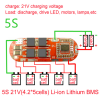SentinelAeon
Member
I am building a homemade bluetooth speaker. It consists of 2x25W bluetooth amplifier (voltage 10-25V input), some 2x20W speakers and batteries from old laptop batteries. I decided to use 5 batteries in series to give me 21V. I ordered BMS board for those 5 batteries. All that is left now is to find a way to charge the speaker. I am looking for the cheapest option, i made 2 images, 2 versions of how i plan to do this. First option is to just hook everything to 21V DC power suply and pray that BMS makes sure charging is ok. Second option is to just buy 5 cheap chargers for 70 cents a piece on ebay and charge each battery individualy, and connect all 5 chargers to 1 power suply.
Version 1:

Version 2:

Version 1:

Version 2:


